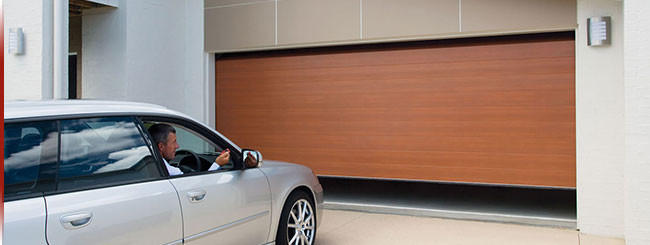
Simple steps to a better garage door
Have you inspected the level of your garage door safety? According to recent statistics, auto accidents happen within five miles of your home. Yet, what is often overlooked is the place where you park your car. Worn, malfunctioning or improperly installed garage doors and openers have injured many children. A simple inspection can guarantee a quieter, longer lasting as well as improve your overall garage door safety
Garage Door Safety
Many injuries occur, especially to children when a closing door fails to stop and reverse direction upon contact. Usually this is because the down force settings are too high. The down force setting is a knob on the back of the opener that typically has an adjustment range of one through nine. Keep in mind not all devices that open and close the garage doors are necessarily safe. Some older openers are equipped with a mechanism that only stops the door from closing when it strikes an object, not reversing the door in the process.
A simple test can be completed, for checking the proper down force. Start with the door fully open and attached to the opener. Under the center of the door, place a 1 ½ inch thick piece of wood, such as a 2-by-4, flat on the floor. Electric garage door openers should reverse the door upon hitting the wood with minimum pressure. If the door does not reverse, decrease the down force by turning the control counterclockwise. Make adjustments in small increments until the door reverses normally. After each adjustment, run the opener through a complete cycle.
If the door reverses during the closing, increase the down force by turning the control clockwise.
Make small adjustments until the door completes a close cycle. After each adjustment, run the opener through a complete travel cycle. Do not increase the force beyond the minimum amount required to close the door.
Checking Open Force
Just as there is a force to go down, there is a force to raise the door. Grasp the door bottom when the door is about halfway through open travel. The door should stop. If the door is hard to hold or doesn’t stop, decrease the open force by turning the control counterclockwise.
Make small adjustments until the door stops easily and opens completely. After each adjustment, run the opener through a complete travel cycle. Do not increase the force beyond the minimum amount required to open the door.
If the door does not open at least 5 feet, increase the open force by turning the control clockwise. Make small adjustments until the door opens completely.
After each adjustment, run the opener through a complete travel cycle. Do not increase the force beyond the minimum amount required to open the door. Prior to 1982, openers had devices intended to reverse the closing door when it strikes an object, but for reasons related to age, installation and maintenance, these products may not be safe enough to prevent child entrapment.
Photoelectric Eyes
Here are two simple tests to determine if the electronic eyes are installed and functioning properly. The non-contact reversal test beings with the door fully open. Standing just outside the path of the door and using the transmitter, push the button to close the door. Wave an object across the path of the photoelectric eye beam as the door is closing. The door MUST reverse and return to the fully open position to pass this test.
Checking for proper location of the photoelectronic eyes is perhaps the simplest test. If present, the device must be mounted at a maximum of 6 inches above the floor to detect an obstruction in the path of the door. Using a tape measure, confirm the device is no higher than 6 inches above the floor or make adjustments if need. To ensure safety, the wall mounted control should be positioned at a minimum height of 5 feet.
A properly maintained garage door will not only
provide your customers with years of service, but will also ensure their safety.
Action Door always recommends professional installation and repair of all garage door systems. These systems are operated under extreme tension which could result in serious bodily injury, property damage, or death if proper safety procedures are not observed.
Fill out a free estimate or contact the Action Door office closest to you for more information.

 Project Gallery
Project Gallery Locations
Locations Free Estimate
Free Estimate